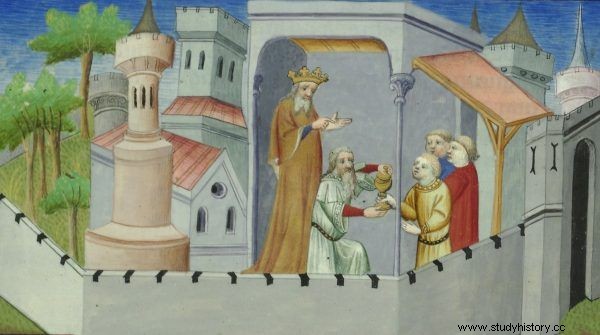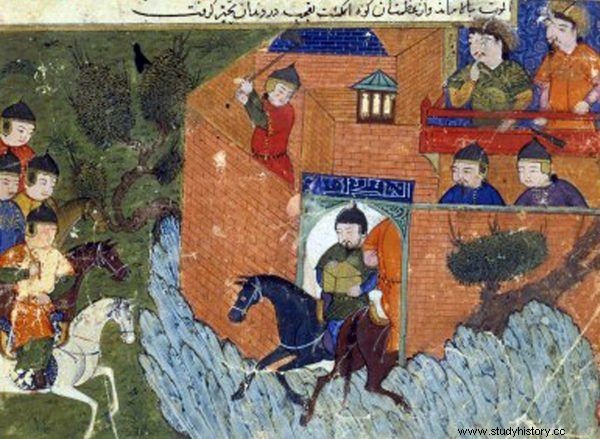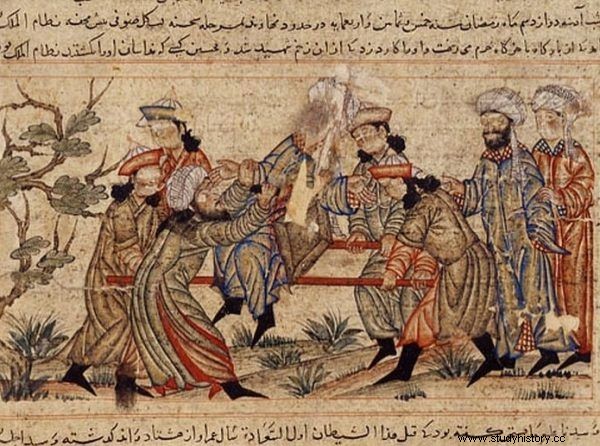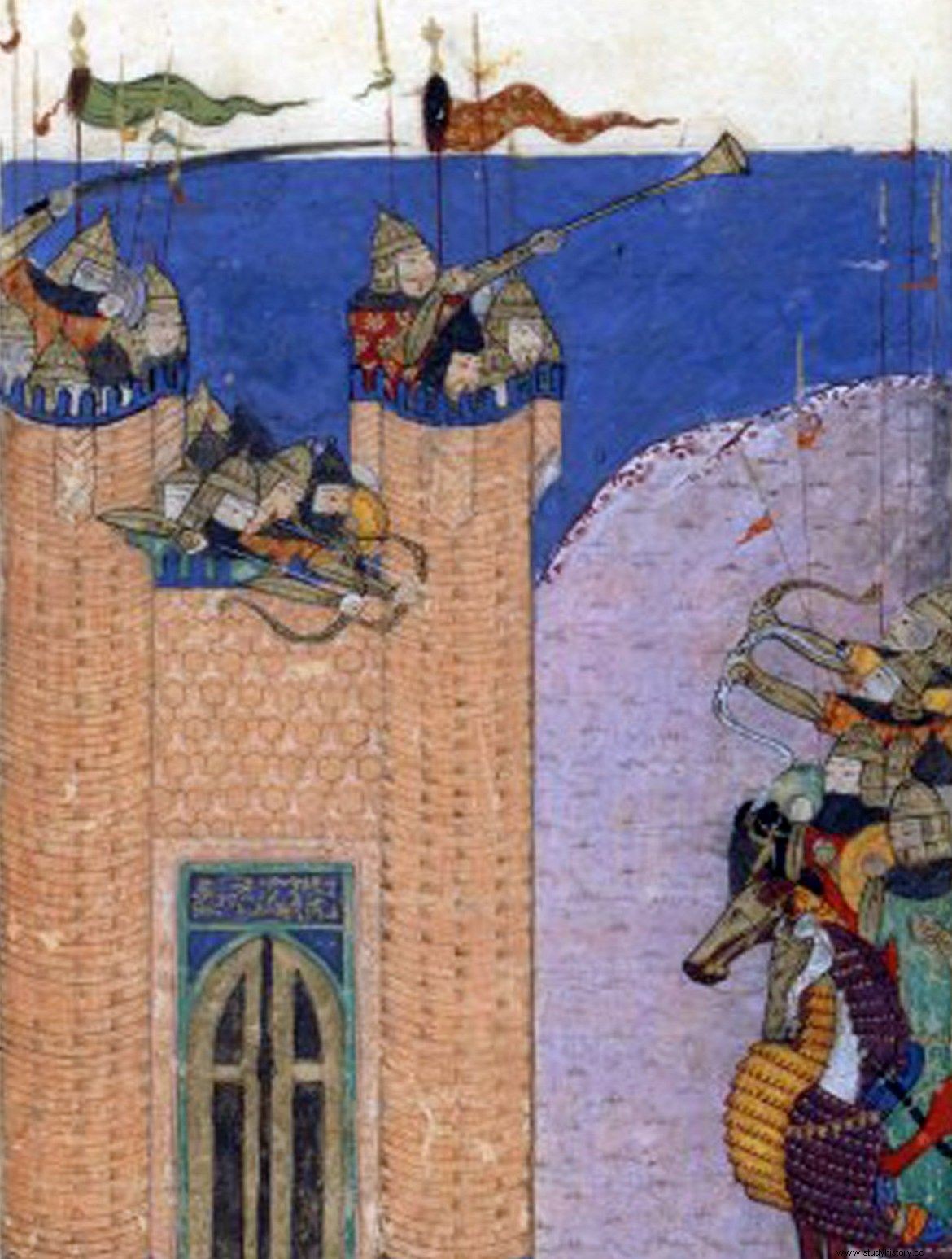Intoxicated with hashish, devoid of all moral restraints, ruthless killers. Such a legend was provided to the Assassins by the followers of Islam, and the crusaders took over and popularized them. There is not much truth to all of this ... Except for the fact that the Assassins did kill someone from time to time.
Who among us has not heard of Assassins? They penetrated popular culture mainly through computer games and movies. We have some idea of these unrivaled drug-intoxicated killers. Most of this image consists of myths and half-truths. It's high time to find out the truth!
1. They called themselves assassins
No assassin would, of course, ever call himself an Assassin - this term comes from the Persian hashishiya and means a hash-taker, that is, according to the criteria of the 21st century, a drug addict.
Hashish was a significant element of the black legend that surrounded the Assassins almost from the beginning of their existence, that is, from the end of the 11th century. It was then that the faction of Shiism was created, whose followers called the Nizarites . Unfriendly tongues proclaimed that the leaders of the sect brainwashed its members by administering a drug and visualizing paradise, thus forcing them to commit murders.

Most of the popular knowledge about assassins comes from Marco Polo, who wrote down post factum… mostly rumors and rumors. The illustration shows the caravan of the famous traveler on his way through Asia (author:Abraham Cresques, "Atlas catalan", source:public domain).
2. They tempted with paradise on earth
A colorful vision of the assassins' actions is preserved in Marco Polo's "Describing the World". The traveler noted:
He had the largest and most beautiful garden ever seen in the valley between two mountains. There was all kinds of good things, and there was an abundance of plants and flowers there. Every fruit of the world was there and every tree of every sort what he could find. There he ordered to build the most beautiful houses, the most beautiful palaces that could be seen (...).
And there were the loveliest ladies and virgins in the world , able to play all instruments and sing sonorously and sweetly and dance around the spas, more beautiful than other women. It was a real delight, and they were especially adept at luring and caressing beyond imagination. And the old man of the mountains was telling his people that this garden was a paradise.
The old man Marco writes about is Hasan Ibn al-Sabbah - the first leader of the Nizaris, the creator of their strategies and the author of their first successes. Marco continues:
Sometimes when the Old Man wanted to kill a ruler who fought with him or was his enemy, he would cause some of these youths to go to paradise for four, ten, or twenty he wished it, like that. He ordered them to be given opium, after which they fell asleep immediately and slept for three days and three nights. Then he had them carried to that garden and made them wake up.

The old man of the mountains, Hasan Ibn al-Sabbah (left) and the fortress of Alamut (right), two pillars of Marco Polo's evocative message (source:public domain).
Then they saw beautiful women singing, playing, caressing them and having fun with them in ways beyond imagination by giving them food and the finest wines, so drunk with so many pleasures and streams of wine and milk, they began to believe that they were truly in paradise.
And of course, they dreamed of nothing else than being back in it, which was most easily accomplished by being chopped up and previously killing a designated enemy.
The trouble is, Marco writes here about a situation that was supposed to take place in the Nizarite capital, which was the inaccessible mountain fortress of Alamut. And this one - mighty for a fortress - might have housed a small vegetable garden, but not a Garden of Eden in any way. Apart from the fact that the Venetian traveler had never been to Alamut and was only relying on the accounts of his companions.
In turn when they visited it for nearly half a century, it was only a picturesque ruin, completely destroyed in 1256 during the Mongol invasion. In fact, Marco Polo is compiling here just numerous legends produced in bulk by the Seljuk Turks hostile to the Nizarites and written down later in the accounts of the Crusaders.
3. They were under the influence of drugs
The Nizari sect required its members to perform complex rituals and introduce successive levels of initiation, which in turn made it easier for the Seljuks to generate accusations of witchcraft, deviation from faith, conflict with the devil, or even atheism.
In their propaganda, therefore, they became Nizaris assassins - drug-stunned killers with supernatural, hellish powers. The world of the medieval imagination eagerly fed on such legends.
One thing is certain - the Assassins did not act under the influence of hashish. This drug, hallucinogenic and confusing to human motor coordination, would rather prevent the bomber from hitting the spot, not to mention hitting the target.

Stuffing young adepts of the Nizari trade with hashish? This is how the illustrator of "Describing the World" Marco Polo (source:public domain) envisioned it.
It is possible, however, that hashish, then a common drug in this part of the world, was used in Nizaris' religious rituals to induce trance states.
4. They were bitter enemies of Christianity
Interestingly, the Nizari with the Crusaders were usually on good terms by not showing excessive hostility towards Christians, and sometimes even entering into alliances with them.
The state of the Nizaris probably had no official name. Only the one that the Seljuks invented in propaganda has survived to our times:Mulehet, which translates from Arabic as:heretic, dissent.
5. Only their enemies made their legend
Admittedly, the Seljuks had reason to slander the Nizaris. Beginning in the 1190s, they experienced defeat after defeat in their clashes with the latter, completely against the military logic. First, by deception and without a fight, they snatched the aforementioned Alamut from them. Later, taking advantage of the reluctance of the population towards a foreign and by no means benign dynasty, they managed to take over another high mountain fortress.
Despite numerous attempts, the mighty Turkish army was not able to realistically threaten the existence of the entire sect. When the Nizari occupied several more strongholds in Syria shortly after, a peculiar, small but surprisingly durable state was created that must be reckoned with by both Muslims and Crusaders.

The Nizari had much more trouble with the Mongols, for example, than with the Crusaders. One of the sieges of the Alamut fortress in the miniature (source:public domain).
Of course, such a small organism did not have the forces that could face any major army in the open field which Sabbah was well aware of. So he developed a plan that was basically the foundation of Islamic terrorism - his fighters, called fida'i, were to attack and eliminate selected targets, and in addition to do it in such a way that the news of the attack would immediately spread around the world .
6. The killers acted many times
It was a well-thought-out spectacle - it was the first time that terror was disseminated using the only mass medium available at the time:an oral story. And the more storytellers, the more mass the medium. They were killed in public places - at the entrances to mosques, in war camps, in the marketplaces ... The latter fact determined that actually there were always suicide bombings.
In 1092, the Seljuk vizier Nizam al-Mulk, the founder of the first Islamic universities, was murdered in this way. In 1103, the emir of Himsu, Dżanah ad-Dauli, and three years later the emir of Apamea, Khalaf Ibn Mula'ib fell victim to the assassins. Several decades later, in 1175, three Assassins, in agreement with the Crusaders, tried to kill Saladin himself, but this time unsuccessfully - they died after a supposedly desperate fight.
This did not save Saladin from the spectacular catastrophe at Montgisard, but he survived. Their actions were so loud that soon almost every kill in the region was attributed to assassins . And that was exactly what Sabbah wanted - in fact, he didn't have to kill anymore, the mere threat was enough. He ruled over the whole countryside like a tyrant Marco continues.

A 14th-century painting of the Assassins killing Nizam al-Mulk (source:public domain).
7. They were trained killing machines
In fact, these killings were probably relatively few and the targets carefully selected. Although it is impossible to establish a certain number today - once, because at some point they were already attributed to every crime, two - because the Nizari centers had a lot of autonomy and conducted local politics at their own discretion, and thirdly - with the conquest and destruction of Alamut, they were lost. all the writings of the sect.
There are also no indications that the bombers received any special training - it would make sense if the enforcer were to survive or use some complicated tool. In the event of a suicide attack by a dagger, it would simply be a waste of time.
8. They plundered and plundered the local population
The black legend of the Assassins is most certainly… just a legend. Medieval authors accused the Nizaris of a dissolute lifestyle, drunkenness and incessant orgies, combined with rape and robbery of the local population. However, the facts show that it was exactly the opposite.

The history of the Nizaris state ended with the conquest of Alamut by the Mongols in 1256. The fortress was demolished and the one who surrendered it turned out badly ... A miniature from the era depicting the siege (source:public domain).
Without radical discipline and sober planning, such a small state would not have survived surrounded by powerful powers joined by another threat - the armies of the Crusaders. Meanwhile, playing wisely with alliances and fear, the Nizarites managed to hold their positions for one hundred and seventy years. It would not be possible without the support of the local population which, therefore, was rather not plundered, but even protected from being plundered by the Seljuqs.
The end of Mulehet came in 1256, when the Mongol armies entered the action. Due to the fact that from 1253 the Mongols occupied another Nizari fortress in Kuhistana and came much closer to Alamut, Rukn ed-din Khurshach undertook negotiations and surrendered the fortress. However, it did not turn out well. After an initial good reception at the Mongolian court, he was soon murdered. But not by the Assassins, though the tool was also a dagger. The last ruler of Alamut was killed by the Mongols.
